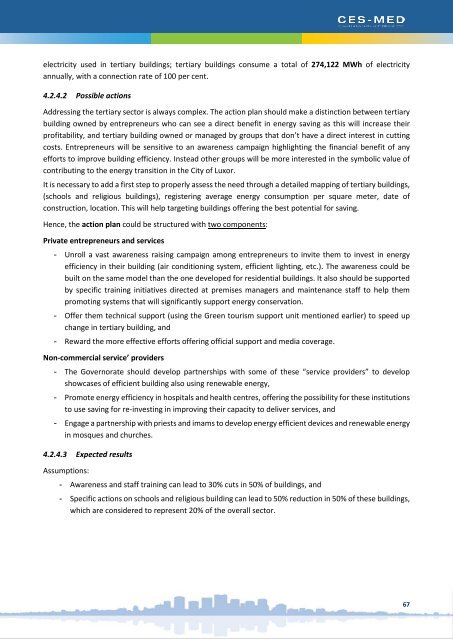130218_Luxor-Egypt SECAP Final
Create successful ePaper yourself
Turn your PDF publications into a flip-book with our unique Google optimized e-Paper software.
electricity used in tertiary buildings; tertiary buildings consume a total of 274,122 MWh of electricity<br />
annually, with a connection rate of 100 per cent.<br />
4.2.4.2 Possible actions<br />
Addressing the tertiary sector is always complex. The action plan should make a distinction between tertiary<br />
building owned by entrepreneurs who can see a direct benefit in energy saving as this will increase their<br />
profitability, and tertiary building owned or managed by groups that don’t have a direct interest in cutting<br />
costs. Entrepreneurs will be sensitive to an awareness campaign highlighting the financial benefit of any<br />
efforts to improve building efficiency. Instead other groups will be more interested in the symbolic value of<br />
contributing to the energy transition in the City of <strong>Luxor</strong>.<br />
It is necessary to add a first step to properly assess the need through a detailed mapping of tertiary buildings,<br />
(schools and religious buildings), registering average energy consumption per square meter, date of<br />
construction, location. This will help targeting buildings offering the best potential for saving.<br />
Hence, the action plan could be structured with two components:<br />
Private entrepreneurs and services<br />
- Unroll a vast awareness raising campaign among entrepreneurs to invite them to invest in energy<br />
efficiency in their building (air conditioning system, efficient lighting, etc.). The awareness could be<br />
built on the same model than the one developed for residential buildings. It also should be supported<br />
by specific training initiatives directed at premises managers and maintenance staff to help them<br />
promoting systems that will significantly support energy conservation.<br />
- Offer them technical support (using the Green tourism support unit mentioned earlier) to speed up<br />
change in tertiary building, and<br />
- Reward the more effective efforts offering official support and media coverage.<br />
Non-commercial service’ providers<br />
- The Governorate should develop partnerships with some of these “service providers” to develop<br />
showcases of efficient building also using renewable energy,<br />
- Promote energy efficiency in hospitals and health centres, offering the possibility for these institutions<br />
to use saving for re-investing in improving their capacity to deliver services, and<br />
- Engage a partnership with priests and imams to develop energy efficient devices and renewable energy<br />
in mosques and churches.<br />
4.2.4.3 Expected results<br />
Assumptions:<br />
- Awareness and staff training can lead to 30% cuts in 50% of buildings, and<br />
- Specific actions on schools and religious building can lead to 50% reduction in 50% of these buildings,<br />
which are considered to represent 20% of the overall sector.<br />
67

















